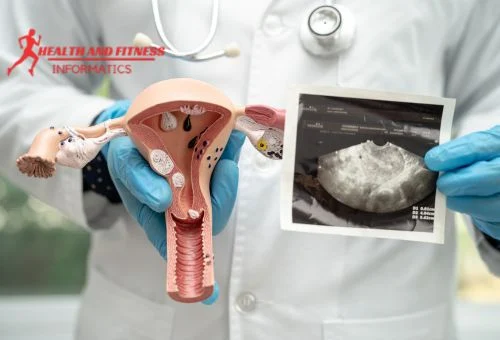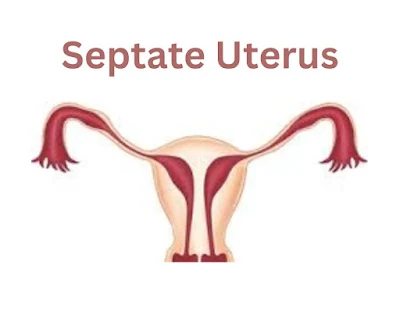Septate Uterus (Uterine Septum): Causes, Symptoms, and Treatment Options
A septate uterus
or uterine septum is a congenital (present at birth) abnormal condition that
may impact the female reproductive system. In this condition, the uterus is
divided into two parts, and this division occurs by a membrane known as the septum.
This condition can cause miscarriage and pregnancy complications and can only be
corrected with surgical procedures.

What is a septate uterus?
A septate uterus is an abnormal type of
uterus in which your uterus is split into two parts by a membrane called a septum.
A septum may vary in length and thickness. A septate uterus present at birth can
significantly influence a female’s fertility and overall reproductive health.
A normal uterus is an upside-down pear-shaped
hollow cavity. If you have a septate uterus, your uterus, instead of one cavity,
has two smaller holes. It starts at the top of your uterus and may expand to
your cervix and occasionally to the vagina, while the cervix is the bottom of
the uterus. This is due to the septum working as a barrier, or partition, in
the uterus.
Some females may experience symptoms, but
most won’t be aware they have a septate uterus until they experience multiple
miscarriages or get pregnant. But there is a possibility to have a healthy
delivery and pregnancy if you are having a septate uterus.
Editor's picks
Bicornuate uterus causes, symptoms, and treatment
Subclinical hypothyroidism in pregnancy
Is having a septate uterus bad?
Having a septate uterus isn't usually a big problem and doesn't lead to lasting health issues. However, it might make you more likely to have a miscarriage or lose pregnancies often. According to a study, about 35% of people with a septate uterus have miscarriages. For those with a normal-shaped uterus, the miscarriage rate is around 10% to 20%. But it's important to know that not everyone with a Septate Uterus has a miscarriage.
How common is a septate uterus?
A septate uterus
is not common, but it's among the more frequent irregularities found in the
uterus. It makes up around 35% to 90% of all the irregularities in the uterus
that people are born with. These kinds of irregularities happen in about 4% of
all individuals who have a uterus.
Will I lose my pregnancy if I have a septate uterus?
If you have a septate uterus or another uterine irregularity, your risk of having a miscarriage goes up. Nonetheless, many people have successful pregnancies even if there's a septum in their uterus. Normally, having a septate uterus doesn't have much impact on getting pregnant or being fertile.
What are the common symptoms of septate uterus?
1. Recurrent miscarriages
One of the most
common symptoms of a septate uterus is recurrent miscarriages. The septum can
affect the implantation of the embryo and the development of the placenta,
leading to an increased risk of pregnancy loss.
2. Infertility
Women with a septate
uterus might face challenges in getting pregnant. The septum can interfere with
the embryo's ability to implant properly in the uterine lining.
3. Painful menstrual periods
Some women with a
septate uterus might experience more severe menstrual cramps than usual due to
the abnormal shape of the uterus.
4. Preterm birth
If a woman with a septate uterus does become pregnant, there is a higher risk of preterm birth due to the structural limitations of the uterus.
What are the causes of septate uterus?
The exact cause of a septate uterus isn't always clear, but it is
believed to result from incomplete absorption of the tissue that divides the
uterus during fetal development. This congenital anomaly can be identified
during a woman's reproductive years when she experiences difficulty conceiving
or maintaining a pregnancy.
How do health experts diagnose septate uterus?
Diagnosing a septate uterus usually involves a combination of physical examinations, imaging tests (ultrasound and hysteroscopy), and medical history. A hysteroscopy is particularly effective in directly visualizing the uterine cavity and the septum.
Treatment options for septate uterus
a. Surgical correction
The main way to treat
a septate uterus is through a procedure called hysteroscopic metroplasty. This
is done on an outpatient basis and usually takes around an hour. During the
procedure, surgical tools are put into the uterus through the cervix. The
tissue that creates the septum in the uterus is then removed. After this
surgery to fix a septate uterus, the risk of having a miscarriage goes down.
This procedure is
minimally invasive and has a high success rate in improving fertility outcomes.
After receiving treatment, a lot of individuals can still have a chance
to get pregnant, even if they've experienced multiple pregnancy losses before.
According to a study, the rate of getting pregnant after having hysteroscopic
metroplasty is about 65%. However, most medical professionals suggest waiting
for about two months after the surgery before trying to conceive.
b. Fertility treatments
In some cases,
fertility treatments such as in vitro fertilization (IVF) might be recommended,
especially if other factors contribute to fertility challenges.
What are the complications that may occur in treating a septate uterus?
The risks linked with
fixing the septate uterus are:
- Cervix damage
- Perforation of uterus
- Infection
- Abnormal bleeding
Read also Mottled Skin
Can a septate uterus grow back?
No, a septate uterus cannot grow back. The formation of a septum in the uterus happens when two ducts fail to join during development. Once it's removed through surgery, your body cannot regrow a uterine septum.
Can I have a normal pregnancy with a septate uterus?
Yes, it’s possible you have a normal pregnancy with a septate uterus. However, there are numerous risks you should be aware of if you are pregnant
with a Septae Uterus.
- Baby being breech
- Low birth weight/restricted growth
- Preterm birth
- Miscarriage
- Premature labor
Recovery
After a surgical correction, most women can expect a relatively quick
recovery. It's important to follow postoperative care instructions provided by
your healthcare provider. With proper treatment, the outlook for women with a
septate uterus improves significantly, increasing the chances of successful
pregnancies.
Prevention
How can I prevent a septate uterus?
There is no means of preventing having a septate uterus. It’s a
condition present at the time of birth. However, there is no evidence that a
septate uterus is a genetic defect.
Conclusion
A septate uterus is a congenital condition that can impact a woman's
fertility and reproductive health. Understanding the causes, symptoms, and
available treatment options is crucial for women who suspect they might have
this condition. Consulting a healthcare provider and considering appropriate
treatment can help improve fertility outcomes and enhance the chances of a
successful pregnancy.






Post a Comment